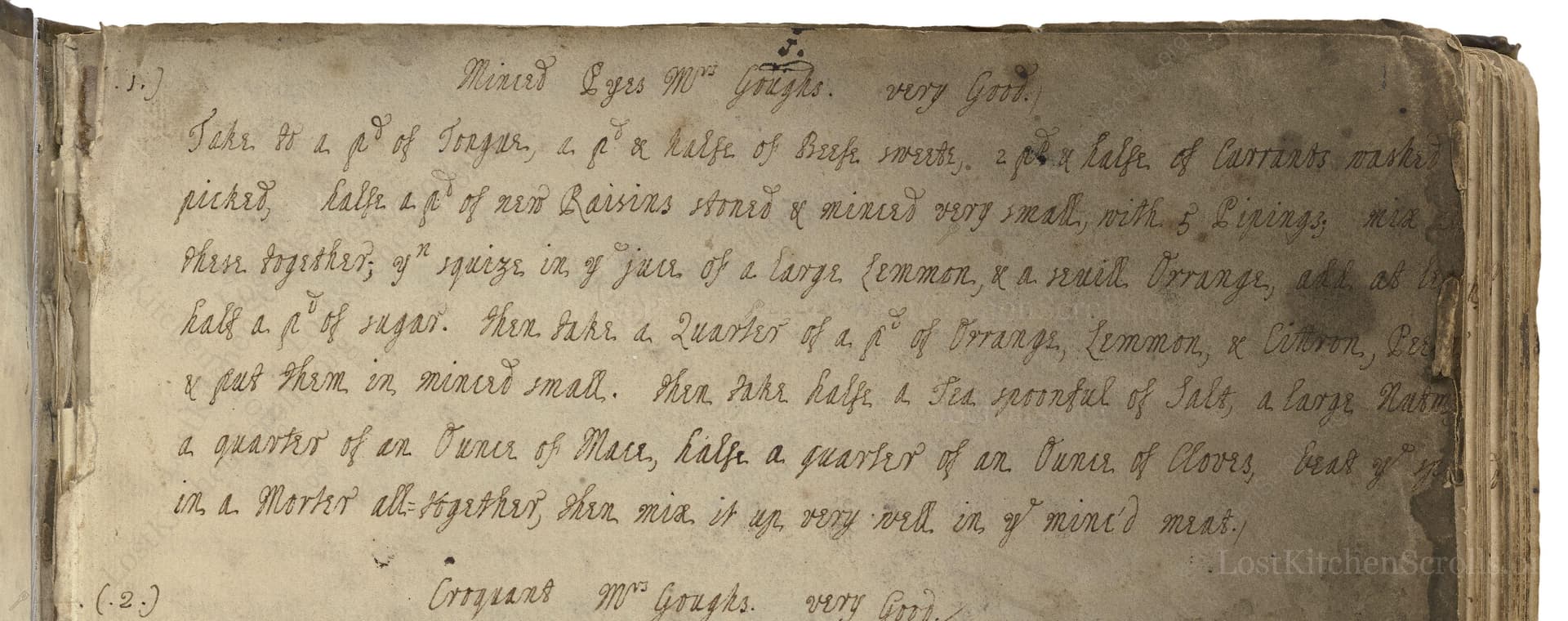Minced Pies Mrs Gough's Way
From the treasured pages of Cookery and medicinal recipes of Dorothy Pennyman
Written by Dorothy Pennyman

Minced Pies Mrs Gough's Way
"Take 1/2 a pd of Tongues pickel'd, halfe a pd of new Raisins ston'd & minced very small, with 5 Pipings, mix these together; yn squize in ye juice of a large Lemmon, & a sevill Orrange, add as half a pd of sugar. Then take a Quarter of a pd of Orange, Lemmon, & Citron, Peel & put them in minc'd small. Then take halfe a Tea spoonful of Salt, a large Nutmeg a quarter of an Ounce of Mace, halfe a quarter of an Ounce of Cloves, beat ye spices in a Mortar all-together, then mix it up very well in ye minc'd meat."
Note on the Original Text
The recipe is written in a straightforward 'receipt' style common in Georgian England, listing ingredients intermingled with directions—more a record for experienced cooks than complete beginners. Spelling is idiosyncratic ('pyes' for pies, 'pickel'd' for pickled, 'yn' for then, 'sevill' for Seville) and reflects the lack of formalized spelling or punctuation in early 18th-century English. Measurements are given in pounds (pd), quarters, and ounces, and instructions assume a working knowledge of kitchen techniques. Terms like 'Pipings' refer to strips or pieces of preserved peel. There are no baking times or temperatures, as hearth cooking depended upon practice and experience.

Title
Cookery and medicinal recipes of Dorothy Pennyman (1730)
You can also click the book image above to peruse the original tome
Writer
Dorothy Pennyman
Era
1730
Publisher
Unknown
Background
A delightful glimpse into early Georgian kitchens, this culinary manuscript compiled by Dorothy Pennyman showcases the elegant tastes and recipes of 18th-century England—perfect for those hungry for a taste of history.
Kindly made available by
Folger Shakespeare Library
This recipe comes from the early 18th-century manuscript collection of Dorothy Pennyman, dated around 1730, from England. In this era, 'pyes' or pies were a mainstay of both everyday and celebratory tables, often blending savory and sweet elements—a tradition especially embodied in mincemeat pies. The inclusion of preserved tongue and candied citrus peels, along with robust spices, reflects the luxurious and cosmopolitan tastes of the gentry. Such recipes were often passed down in manuscript form, handwritten by women for use in well-off households, standing as a testament to both their culinary skill and the reach of trade (spices, sugar, citrus) in Georgian Britain.

Cooks in the 18th century would use a sturdy wooden chopping board, a heavy kitchen knife for mincing the tongue and fruit, and a mortar and pestle to crush spices to a fine powder. The mixing would take place in a large earthenware or pewter bowl, using a wooden spoon. Pastries were shaped by hand or in pie tins, and everything would be baked in a brick oven fired by wood or coal, with careful attention to heat.
Prep Time
25 mins
Cook Time
25 mins
Servings
12
We've done our best to adapt this historical recipe for modern kitchens, but some details may still need refinement. We warmly welcome feedback from fellow cooks and culinary historians — your insights support the entire community!
Ingredients
- 8 ounces pickled or salted ox tongue, finely minced (substitute: cooked beef tongue or brined beef brisket)
- 8 ounces seedless raisins, finely chopped
- 5 pieces (about 1 ounce) candied citron peel, chopped (or mixed candied citrus peel)
- Juice of 1 large lemon (approx. 3-4 tbsp)
- Juice of 1 Seville (bitter) orange, or substitute regular orange (approx. 3-4 tbsp)
- 8 ounces granulated sugar
- 4 ounces mixed candied orange, lemon, and citron peels, chopped
- 1/2 teaspoon sea salt
- 1 whole nutmeg, grated
- 1/4 ounce (about 2 teaspoons) ground mace
- 1/8 ounce (about 1 teaspoon) ground cloves
Instructions
- Begin by finely mincing 8 ounces of pickled ox tongue (substitute with cooked, salted beef tongue if needed).
- Pit and chop 8 ounces of fresh, seedless raisins.
- Combine with five small pieces of preserved citron peel (or diced candied citrus peel if unavailable).
- Squeeze in the juice of one large lemon and one Seville orange (a regular bitter orange can substitute)—roughly 3-4 tablespoons of juice each.
- Add 8 ounces of granulated sugar.
- Finely dice 4 ounces of a mixture of candied orange, lemon, and citron peels.
- In a mortar and pestle, grind together 1/2 teaspoon salt, one whole grated nutmeg, 1/4 ounce (about 2 teaspoons) of mace, and 1/8 ounce (about 1 teaspoon) of cloves.
- Thoroughly blend these spices into the minced mixture.
- Use this rich, sweet-meaty mélange as a filling for small pies or pastries.
- Bake in preheated oven at 350°F until golden (around 20-25 minutes if making small mince pies).
Estimated Calories
285 per serving
Cooking Estimates
You will need about 25 minutes to prepare everything—this covers mincing, chopping, juicing, and mixing. Baking the pies takes about 25 minutes. Each of the 12 pies contains around 285 calories.
As noted above, we have made our best effort to translate and adapt this historical recipe for modern kitchens, taking into account ingredients nowadays, cooking techniques, measurements, and so on. However, historical recipes often contain assumptions that require interpretation.
We'd love for anyone to help improve these adaptations. Community contributions are highly welcome. If you have suggestions, corrections, or cooking tips based on your experience with this recipe, please share them below.
Join the Discussion
Rate This Recipe
Dietary Preference
Culinary Technique
Occasions

Den Bockfisch In Einer Fleisch Suppen Zu Kochen
This recipe hails from a German manuscript cookbook compiled in 1696, a time whe...

Die Grieß Nudlen Zumachen
This recipe comes from a rather mysterious manuscript cookbook, penned anonymous...

Ein Boudain
This recipe comes from an anonymous German-language manuscript cookbook from 169...

Ein Gesaltzen Citroni
This recipe, dating from 1696, comes from an extensive anonymous German cookbook...
Browse our complete collection of time-honored recipes



